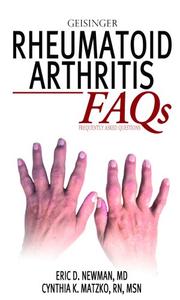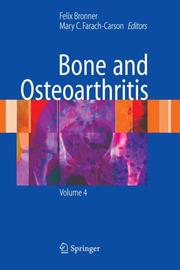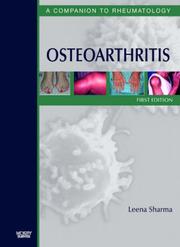| Listing 1 - 10 of 19 | << page >> |
Sort by
|
Book
Year: 2007 Publisher: Rockville, MD : Agency for Healthcare Research and Quality (US),
Abstract | Keywords | Export | Availability | Bookmark
 Loading...
Loading...Choose an application
- Reference Manager
- EndNote
- RefWorks (Direct export to RefWorks)
Antirheumatic agents. --- Arthritis. --- Arthritis
Book
Year: 2007 Publisher: Rockville, MD : Agency for Healthcare Research and Quality (US),
Abstract | Keywords | Export | Availability | Bookmark
 Loading...
Loading...Choose an application
- Reference Manager
- EndNote
- RefWorks (Direct export to RefWorks)
Antirheumatic agents. --- Arthritis. --- Arthritis

ISBN: 9781550093414 Year: 2007 Publisher: Hamilton BC Decker Inc
Abstract | Keywords | Export | Availability | Bookmark
 Loading...
Loading...Choose an application
- Reference Manager
- EndNote
- RefWorks (Direct export to RefWorks)

ISBN: 9780323070607 0323070604 9780323036221 0323036228 1336234482 Year: 2007 Publisher: Philadelphia : Mosby Elsevier,
Abstract | Keywords | Export | Availability | Bookmark
 Loading...
Loading...Choose an application
- Reference Manager
- EndNote
- RefWorks (Direct export to RefWorks)
This new companion to Hochberg et al.'s Rheumatology masterwork focuses on the momentous recent advances in our understanding of the genetics and immunology of psoriatic and reactive arthritis, and their implications for diagnosis and management. Leading international authorities explore new concepts in genetic and pathogenic mechanisms and early diagnosis; provide comprehensive, well-illustrated coverage of clinical features; evaluate the very latest therapeutic options, including biologics; and discuss clinical outcome measures.Examines the very latest pathogenic mechanisms and diagn
Psoriatic arthritis. --- Infectious arthritis. --- Reactive arthritis --- Arthritis --- Joints --- Psoriatic arthropathy --- Psoriasis --- Infections
Periodical
Abstract | Keywords | Export | Availability | Bookmark
 Loading...
Loading...Choose an application
- Reference Manager
- EndNote
- RefWorks (Direct export to RefWorks)
Arthritis --- Musculoskeletal system --- Arthritis. --- Musculoskeletal Diseases. --- Diseases --- Appareil locomoteur --- Maladies

ISBN: 1846287014 1846285135 Year: 2007 Volume: v. 4 Publisher: London : Springer,
Abstract | Keywords | Export | Availability | Bookmark
 Loading...
Loading...Choose an application
- Reference Manager
- EndNote
- RefWorks (Direct export to RefWorks)
Bone and Osteoarthritis places emphasis on the molecular and cellular events that lead to osteoarthritis, stressing the role of subchondral bone, which distinguishes this from other books on the disease. A novel aspect is the attention given to the possible epigenetic basis, together with a discussion of the genetics predisposing to osteoarthritis. Detailed analyses are given of the role of the synovium, of the molecular mechanisms that lead to degradation of the cartilage matrix, of the hypertrophy of the cartilage cell, of the anabolic and catabolic roles of cytokines, may lead to novel approaches to clinical treatment, utilizing anabolic mediators or molecules that target steps in the disease process. Also discussed are animal models and how mechano-responsiveness is compromised by mechanical injury. Orthopedics and rheumatology have become close conceptually, as advances in bone and joint biology have enabled bench and translational scientists, as well as practitioners, to approach clinical problems comprehensively. Because bone plays a role in initiating osteoarthritis, therapeutic approaches focusing on bone tissue are included in the discussion of novel treatments. The general topic of osteoarthritis is therefore a timely subject for a series on bone biology. This book, intended for clinicians, researchers and students, provides information that will orient the novice and update the specialist. No other book treats the relationship of bone to osteoarthritis in similar fashion or provides a comparable underpinning of joint pathophysiology.
Osteoarthritis --- Bone. --- Pathogenesis. --- Bones --- Calcification --- Connective tissues --- Skeleton --- Degenerative arthritis --- Degenerative joint disease --- Joint disease, Degenerative --- OA (Disease) --- Old age arthritis --- Osteoarthrosis --- Wear and tear arthritis --- Arthritis

ISBN: 0323070647 0323039294 1336227257 9780323070645 9780323039291 Year: 2007 Publisher: Philadelphia Mosby
Abstract | Keywords | Export | Availability | Bookmark
 Loading...
Loading...Choose an application
- Reference Manager
- EndNote
- RefWorks (Direct export to RefWorks)
This new companion to Hochberg et al.'s Rheumatology masterwork presents current insights into the causes, detection, and therapy of this condition. It provides ""one-stop"" coverage of scientific and clinical developments, including new concepts in epidemiology and genetics and pathogenic mechanisms · new developments in diagnostic interventions and prevention · and the very latest concepts in treatment.Features the work of leading experts in osteoarthritis. Presents current diagnostic criteria and knowledge of pathogenic mechanisms.Discusses the very latest advances
Osteoarthritis. --- Rheumatology. --- Internal medicine --- Connective tissues --- Joints --- Degenerative arthritis --- Degenerative joint disease --- Joint disease, Degenerative --- OA (Disease) --- Old age arthritis --- Osteoarthrosis --- Wear and tear arthritis --- Arthritis --- Diseases
Book
Year: 2007 Publisher: Oslo, Norway : Knowledge Centre for the Health Services at The Norwegian Institute of Public Health (NIPH),
Abstract | Keywords | Export | Availability | Bookmark
 Loading...
Loading...Choose an application
- Reference Manager
- EndNote
- RefWorks (Direct export to RefWorks)
Background: Treatment with tumour necrosis factor alpha (TNF-α, or simply TNF) inhibitors is considered to be an alternative to the use of traditional disease-modifying anti-rheumatic drugs (DMARDs) in patients with different rheumatic diseases, i.e. rheumatoid arthritis (RA). There are three TNF-inhibitor drugs currently available on the market (brand names in brackets): adalimumab (Humira), etanercept (Enbrel) and infliximab (Remicade). The Norwegian Knowledge Centre for the Health Services has previously summarised the evidence on the drugs' efficacy and safety (in randomised clinical trials and observational studies) while the present report considers cost-effectiveness of the drugs for rheumatoid arthritis. After considerable growth over several years, the aggregate sales of the three drugs amounted to 860 million NOK in 2006. RA is a serious disease, not least from an economic perspective. No cost-of-illness studies have been found for Norway, but studies from Sweden suggest that the costs of the disease are substantial with a large proportion related to loss of work capacity. Methods: We undertook a review of economic evaluations of TNF-inhibitors against RA, and considered an analysis of health-related quality of life data for patients on TNF-inhibitors and DMARD users from a Norwegian observational study. Results: A total of twelve studies from six countries were included in the literature review. The studies were based on health economic models, which were diverse in their characteristics, and therefore the estimates of cost-effectiveness varied significantly. Conclusions: In our review of economic evaluations of TNF-inhibitors, we found significant variation in the type and features of the models used, which led to a wide range of estimates. The potential for direct comparisons of results between the studies, and thus transferability of results into Norwegian setting, is limited. With this in mind, our main conclusions are as follows:1. First line therapy: TNF inhibitors seem not to be cost-effective as first line therapy, based on the one study in which this was considered.2. Second line therapy: We cannot draw any conclusions, since no relevant studies were found.3. Third line therapy: TNF-inhibitors may be cost-effective, particularly in the case of patients in early disease. The drugs are also likely to be more cost-effective for patients who experience a good rather than a moderate response.4. Indirect costs: Prevention of productivity loss may account for considerable savings, but has only been accounted for in a few of the economic evaluations.
Tumor necrosis factor --- Rheumatoid arthritis --- Inhibitors. --- Treatment.
Book
Year: 2007 Publisher: Oslo, Norway : Norwegian Knowledge Centre for the Health Services,
Abstract | Keywords | Export | Availability | Bookmark
 Loading...
Loading...Choose an application
- Reference Manager
- EndNote
- RefWorks (Direct export to RefWorks)
Objectives Metaanalysis of randomised controlled trials has shown that TNF-inhibitors are effective in RA. These trials however are undertaken in highly selective populations; under an experimental setting that may differ from that of clinical practice, and follow up rarely extend beyond 1 year. In addition all trials were sponsored by the manufacturer. We were asked to extend the review and meta-analysis of RCTs with a review of data from registries to evaluate efficacy and safety of TNF-inhibitors when used in clinical practice (real world). We focused particularly on the following questions: What is the efficacy of TNF-inhibitors when used outside clinical trials? What is the efficacy of TNF-inhibitors after long term use? What adverse events are reported in these studies? What is the risk of malignancies following long term use? What are the experiences concerning use of medication, treatment compliance and change of medication? Methods We searched Medline and Embase June 2006 by combining search terms for registries, cohort studies and databases with terms for TNF-inhibitors and rheumatoid arthritis (RA). We included publications from registries or databases on adalimumab, etanercept and infliximab for treatment of rheumatoid arthritis (RA), ankylosing spondylitis, psoriatic arthritis or juvenile idiopathic arthritis. Manufacturers were also invited to submit data. Outcomes considered were efficacy, safety and medication use. Results The search gave 290 hits, 64 references were retrieved and assessed in full text, and 23 publications finally included. These studies covered patients with RA, in addition we found one study on juvenile idiopathic arthritis. We did not identify relevant studies on ankylosing spondylitis or psoriatic arthritis. The summary of the results from the studies are as follows:1. Effectiveness: We included seven studies from registries and databases reporting clinical effects of TNF-inhibitors. In summary these studies showed that TNFinhibitors were effective also when used in clinical practice. The effect however appeared to be lower compared with RCTs. This could be explained by a more heterogeneous patient population. In addition patients in clinical practice often continued with existing medication, opposed to most clinical trials where patients often discontinued existing medications before enrolling. Although we aimed to 9 assess long-term effectiveness, few patients have been followed beyond 2-3 years of treatment. One study assessed patients with JIA, in this study treatment with TNF-inhibitor (etanercept) led to a significant reduction of the disease activity in most of the patients.2. Combination therapy: Two randomised controlled trials and data from registries evaluated the combination of TNF and MTX treatment. Treatment with TNFinhibitors and methotrexate (MTX) appeared more effective than treatment with TNFinhibitor alone in reducing the disease activity in patients with RA. 3. Cancer: We included six publications that assessed cancer risk following TNFtreatment. A general comments to these studies is that patients have not been followed sufficiently long to allow for conclusions regarding cancer risk. Four studies analysed risk of lymphoma or leukaemia, with inconsistent results. Two studies analysed risk of solid cancer, with inconcistent results. Experiences from transplantation patients shows that cancer usually develops 10-15 years after immunosuppressive medication. Hence, these studies does not give any further information about the risk of developing cancer following treatment with TNF-inhibitors than reported in the randomized controlled trials.4. Infections: Treatment with TNF-inhibitors were associated with increase the risk of infections. In particular, the risk of reactivation of latent tuberculosis. However, routine screening and treatment of tuberculosis prior to TNF-treatment have reduced this risk considerably.5. Compliance: Continuation of treatment with TNF-inhibitors (etanercept og infliximab) after one year was between 62-73 %. This number is lower than compared with RCTs . The reasons for ceasing TNF-treatment were in most cases adverse events or lack of effect. However, it was found that the compliance to TNF-inhibitors was higher then for traditional DMARDs. Conclusion: In conclusion, results from clinical trials and registries show that TNF-inhibitors are effective, also when used on a broader patient population outside the setting of clinical trials. Treatment with TNF-inhibitors is associated with increased risk of infections, in particular tuberculosis. Included studies does not allow for conclusion regarding risk of cancer. Thus, the issue of long term safety is at time being incomplete, with a follow up of 2-3 years in most studies. A national registry for treatment with TNF-inhibitors (and other biologics) in Norway would be a very helpful tool to identify the effect and adverse events after long treatment with TNF-inhibitors.
Tumor necrosis factor --- Rheumatoid arthritis --- Inhibitors. --- Treatment.
Book
Year: 2007 Publisher: Oslo, Norway : Norwegian Knowledge Centre for the Health Services,
Abstract | Keywords | Export | Availability | Bookmark
 Loading...
Loading...Choose an application
- Reference Manager
- EndNote
- RefWorks (Direct export to RefWorks)
Objectives Metaanalysis of randomised controlled trials has shown that TNF-inhibitors are effective in RA. These trials however are undertaken in highly selective populations; under an experimental setting that may differ from that of clinical practice, and follow up rarely extend beyond 1 year. In addition all trials were sponsored by the manufacturer. We were asked to extend the review and meta-analysis of RCTs with a review of data from registries to evaluate efficacy and safety of TNF-inhibitors when used in clinical practice (real world). We focused particularly on the following questions: What is the efficacy of TNF-inhibitors when used outside clinical trials? What is the efficacy of TNF-inhibitors after long term use? What adverse events are reported in these studies? What is the risk of malignancies following long term use? What are the experiences concerning use of medication, treatment compliance and change of medication? Methods We searched Medline and Embase June 2006 by combining search terms for registries, cohort studies and databases with terms for TNF-inhibitors and rheumatoid arthritis (RA). We included publications from registries or databases on adalimumab, etanercept and infliximab for treatment of rheumatoid arthritis (RA), ankylosing spondylitis, psoriatic arthritis or juvenile idiopathic arthritis. Manufacturers were also invited to submit data. Outcomes considered were efficacy, safety and medication use. Results The search gave 290 hits, 64 references were retrieved and assessed in full text, and 23 publications finally included. These studies covered patients with RA, in addition we found one study on juvenile idiopathic arthritis. We did not identify relevant studies on ankylosing spondylitis or psoriatic arthritis. The summary of the results from the studies are as follows:1. Effectiveness: We included seven studies from registries and databases reporting clinical effects of TNF-inhibitors. In summary these studies showed that TNFinhibitors were effective also when used in clinical practice. The effect however appeared to be lower compared with RCTs. This could be explained by a more heterogeneous patient population. In addition patients in clinical practice often continued with existing medication, opposed to most clinical trials where patients often discontinued existing medications before enrolling. Although we aimed to 9 assess long-term effectiveness, few patients have been followed beyond 2-3 years of treatment. One study assessed patients with JIA, in this study treatment with TNF-inhibitor (etanercept) led to a significant reduction of the disease activity in most of the patients.2. Combination therapy: Two randomised controlled trials and data from registries evaluated the combination of TNF and MTX treatment. Treatment with TNFinhibitors and methotrexate (MTX) appeared more effective than treatment with TNFinhibitor alone in reducing the disease activity in patients with RA. 3. Cancer: We included six publications that assessed cancer risk following TNFtreatment. A general comments to these studies is that patients have not been followed sufficiently long to allow for conclusions regarding cancer risk. Four studies analysed risk of lymphoma or leukaemia, with inconsistent results. Two studies analysed risk of solid cancer, with inconcistent results. Experiences from transplantation patients shows that cancer usually develops 10-15 years after immunosuppressive medication. Hence, these studies does not give any further information about the risk of developing cancer following treatment with TNF-inhibitors than reported in the randomized controlled trials.4. Infections: Treatment with TNF-inhibitors were associated with increase the risk of infections. In particular, the risk of reactivation of latent tuberculosis. However, routine screening and treatment of tuberculosis prior to TNF-treatment have reduced this risk considerably.5. Compliance: Continuation of treatment with TNF-inhibitors (etanercept og infliximab) after one year was between 62-73 %. This number is lower than compared with RCTs . The reasons for ceasing TNF-treatment were in most cases adverse events or lack of effect. However, it was found that the compliance to TNF-inhibitors was higher then for traditional DMARDs. Conclusion: In conclusion, results from clinical trials and registries show that TNF-inhibitors are effective, also when used on a broader patient population outside the setting of clinical trials. Treatment with TNF-inhibitors is associated with increased risk of infections, in particular tuberculosis. Included studies does not allow for conclusion regarding risk of cancer. Thus, the issue of long term safety is at time being incomplete, with a follow up of 2-3 years in most studies. A national registry for treatment with TNF-inhibitors (and other biologics) in Norway would be a very helpful tool to identify the effect and adverse events after long treatment with TNF-inhibitors.
Tumor necrosis factor --- Rheumatoid arthritis --- Inhibitors. --- Treatment.
| Listing 1 - 10 of 19 | << page >> |
Sort by
|

 Search
Search Feedback
Feedback About UniCat
About UniCat  Help
Help News
News